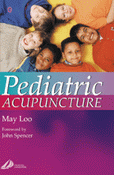Acupuncture & TCM Articles
Pediatrician Recommends Acupuncture as Adjunctive Therapy
Pediatrician Recommends Acupuncture as Adjunctive Therapy
A pediatrician at Brenner Children's Hospital recommends acupuncture as part of a treatment plan for children with chronic pain or nausea, according to a study published in the December issue of Contemporary Pediatrics.
Kathi Kemper, M.D., a pediatrician at Brenner Children's Hospital in Winston-Salem, N.C., says using acupuncture may help relieve some side effects of treatment and make pediatric patients more comfortable.
"I recommend acupuncture be used as an adjunctive therapy for children who experience chronic, recurrent, or severe pain such as migraine, severe chronic abdominal pain and pain associated with cancer and nausea," Kemper said. "Several studies have shown that acupuncture is effective in the treatment of headaches in pediatric patients. Acupuncture is safe and effective. For patients who have no interest in taking additional medications or who are already receiving maximal medical treatment and want help with symptoms, acupuncture is a viable alternative."
Kemper says that patients can gain relief from nausea as well.
"In our clinical experience, pediatric oncology patients often report great relief from a combination of professionally administered acupuncture and over-the-counter acupuncture wrist bands," she said.
Some patients, according to Kemper, prefer acupuncture because its side effects include a greater sense of well-being, enhanced alertness and reduced pain.
Acupuncture is the most familiar of the several therapies that make up traditional Chinese medicine. Traditional Chinese medicine views disease as an imbalance or lack of harmony in the body and prescribes therapies as a way to restore that balance and harmony, Kemper said.
The practice of and research on acupuncture have flourished in the United States over the past 30 years. The Food and Administration, which regulates acupuncture needles as disposable medical devices, estimates that in the 1990s, Americans made 9 million to 12 million annual visits to acupuncturists and spent approximately $500 million each year on acupuncture services.
Despite this growth, access to acupuncture services for most children remains limited because few acupuncturists treat children and few insurance companies provide full coverage for services, Kemper said.
"Many pediatricians rarely think of acupuncture as a therapeutic option due in part to the lack of training in and familiarity with acupuncture," Kemper said.
Another large factor is that pediatricians subscribe to conventional wisdom that children are afraid of needles, Kemper said.
"Our studies have shown that children suffering from severe, chronic pain may be willing to try this alternative," Kemper said. "Many patients who receive acupuncture treatment remark on how much less painful it is than conventional needles and many acupuncturists use a variety of non-needle techniques to stimulate acupuncture points."
Although many children's hospitals -- including Brenner Children's Hospital -- do not currently offer acupuncture services, Kemper says she hopes that as more acupuncturists become available in more mainstream clinical settings and as insurance plans are encouraged to cover the treatment, pediatric access will grow.
For information on how to find and work with an acupuncturist, visit Brenner Children's Hospital's website at http://www.brennerchildrens.org.
 Pediatric Acupuncture Pediatric Acupuncture
by May Loo
A clear explanation of acupuncture and related techniques used in the treatment of children, this practical introduction to the subject explores the important concepts of childhood development and integrates conventional theories with those of TCM. It covers a variety of acupuncture techniques, including non-invasive approaches that are particularly helpful with children.
Full treatment protocols are given for 22 common pediatric conditions, with a particular emphasis on treatments that are safe, simple, and readily accepted by children. Issues of diet and immunization are also explored.
The author is a practicing pediatrician with many years experience in both working with children and as an acupuncture practitioner.
The back matter includes an appendix of acupuncture meridians, a bibliography of general Chinese medicine texts, and an index.
| 